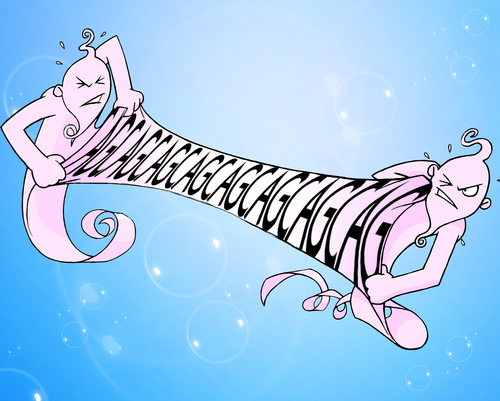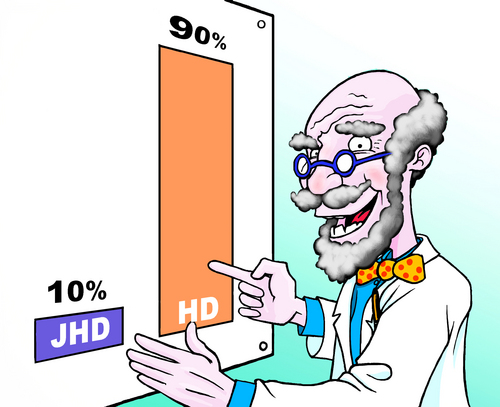What is JHD - Juvenile Huntingtons Disease
What is JHD?
When George Huntington first identified Huntington disease in 1872,
he suggested that the
disease affects adults only. It is now known that Huntington disease can occur in individuals at any age in their life - young or old.
When someone who is 20 or younger develops symptoms of Huntington's disease, they are classed as having Juvenile Huntington's disease (JHD).
So effectively 'JHD' means a young person with Huntington's disease.
Is JHD common?
Less than 10% of cases of Huntington's disease come in the Juvenile form. When you consider that Huntington's disease itself is rare, this highlights just how rare JHD actually is. For reasons which have only recently become clearer, most people (around 90%) with JHD inherit the gene from their father. The reason for this is that the CAG repeats tend to be less stable when passed from the male. In general, CAG repeats usually increase a little when passed from generation to generation. So after a few generations of the gene being passed on, the likelihood of getting symptoms earlier in life also increases. However, this 'increase' seems to be larger when the gene is passed from the male (the father), as opposed the female - where the CAG repeat usually stays around the same. It's important to state that this is not always the case. As with anything regarding Huntington's disease, it is very unpredictable.
Typical early symptoms of juvenile HD
Stiffness of the legs
Clumsiness of arms and legs
Decline in cognitive function
Changes in behaviour
Seizures (In 25-30% of cases, there is a tendency to epileptic seizures - something almost
never seen in adults with HD.)
Speech problems
Behavioural disturbances
It is thought that the progression of JHD may be quicker than that of adult-onset Huntington's disease in some younger people with JHD, although as with adults there is always a huge variation in how someone's condition progresses so it is difficult to know for certain how fast each person's condition will progress.
Why do people get JHD rather than Huntington's
Disease?
Huntington's disease is hereditary - that means that it can be passed down, from parent to child, through genes in our DNA. Genes are passed to you from your parents - that's why you might have hair like your dad, or brown eyes like your mum. We have thousands of genes, and they are all sectioned into different segments in our DNA. These segments are known as chromosomes and in total we have 23 pairs of chromosomes. The reason we have 'pairs' of chromosomes is because we inherit one from each parent.
In 1993, A team of researchers discovered the gene responsible for Huntington's disease on chromosome 4. They found that one part of the gene repeated itself over and over again, like a stutter or when you hold a key down too long on a computer Keeeeeeeeyboard. This repeat is what causes the development of Huntington's disease and is known as a 'CAG repeat'.
Higher CAG repeats
Everybody has two copies of the Huntington's
disease gene, whether they're at risk for Huntington's disease or not. One copy was inherited
from each parent. And every Huntington's disease gene contains a CAG repeat in that gene.
What causes the development of the disease is the number of times the CAG is repeated. Put simply, people who develop Huntington's disease have longer CAG repeats than those that don't. To make things easier to follow, we will split the CAG repeats into different ranges.

26 And lower (Unaffected range) - As we mentioned, everybody has a CAG repeat in their
Huntington's disease genes (even those not in a family affected by Huntington's disease).
Most people who don't have Huntington's disease have around 10-20 CAG repeats. In fact,
anything up to 26 CAG repeats is fine and will not cause any problems. But, once you go
above that, there may be complications.
40 Repeats and higher (disease range) - Anyone with 40 CAG repeats or above is,
unfortunately, certain to develop Huntington's disease in their lifetime, with a 50% risk of
passing the gene on to each of their children as well.
Repeats in the middle range between 27 and 39 are quite rare. They're a bit less
straightforward, and in fact scientists don't understand them fully, so they're sometimes
referred to as the 'grey area'.
Most people that have Huntington's disease
have a CAG repeat between 40-50. For these
people, it is hard to tell when their symptoms
will begin. For example, two people with the
same CAG repeat of 45, could get symptoms
of Huntington's disease at completely different
ages, decades apart. But JHD tends to be
different, people with JHD usually have higher
CAG repeats - around 50+ repeats. This
difference in CAG repeats results in people
getting symptoms at a younger age, earlier in
life.
More information on JHD and HD is available by following the links below
Quick Facts on JHD
Cause: HD allele with large number of repeats, usually inherited from father.
Signs of Onset: Decline in school performance, Behavioral problems, Movement difficulties & Personality changes
Symptoms
Physical symptoms may initially consist of "nervous" activity, fidgeting, twitching, or excessive restlessness.
Handwriting may change and facial grimaces may appear. Day-to-day skills involving coordination and concentration, such as driving, become more difficult.
These initial symptoms will gradually develop into more marked involuntary movements of the head, trunk and limbs - which often lead to problems with walking and balance.
Speech and swallowing can become impaired. Movements generally tend to increase during voluntary effort, stress or excitement and decrease during rest and sleep.
More Facts
Inheritence: 50/50 chance of passing HD allele on to children
In 1993, after a ten-year search, scientists found the gene that causes HD. HD is a degenerative disease whose symptoms are caused by the loss of cells in a part of the brain called the basal ganglia. This damage to cells affects cognitive ability (thinking, judgment, memory), movement, and emotional control.
HD occurs in approximately 1 in 10.000 people in most "western" countries. In other countries the prevelance may be much lower.
If you would like to help raise money for Sheenam's Wish please read on..
You can help Sheenam's Wish to help others with JHD by fundraising, providing ideas for us or donate. Please click on our PayPal Link on the homepage or email us: sheenamswish@gmail.com
Thank you for your help, Sheenam x

